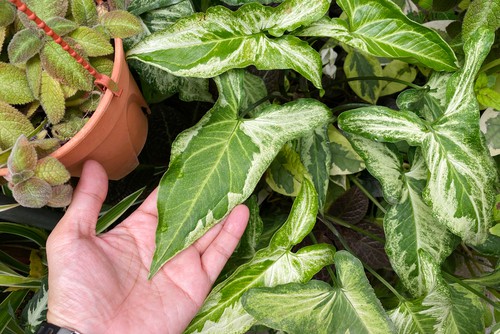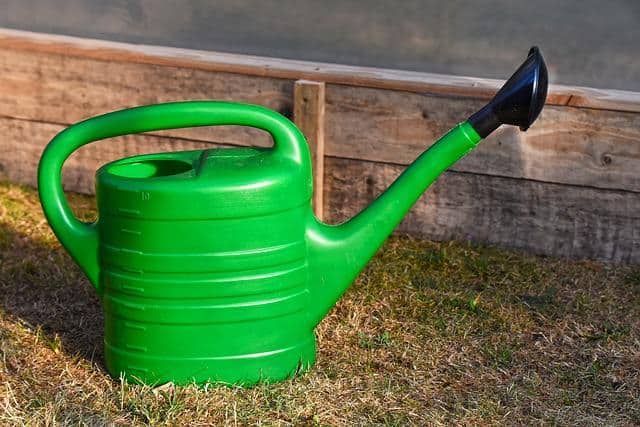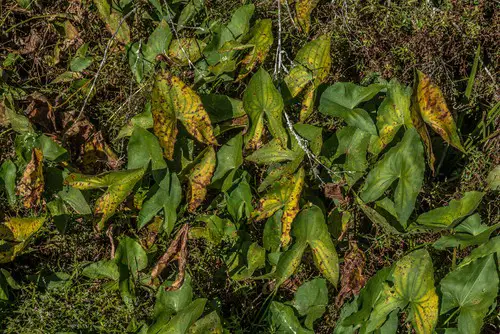Arrowhead plants, also known as Syngonium podophyllum, are popular houseplants because of their beautiful and unique foliage. However, brown spots on arrowhead plant leaves can be a common problem that many plant owners face. These brown spots can be caused by a variety of factors and can have detrimental effects on the plant’s health.
Identifying brown spots on arrowhead plant leaves is the first step in understanding the problem. Brown spots can appear on the tips, edges, or centers of the leaves. The spots can be small or large and can be accompanied by yellowing or wilting of the leaves. It is important to identify the cause of the brown spots to prevent further damage to the plant.
Causes of brown spots on arrowhead plant leaves can range from over or under watering to pests and diseases. Overwatering can lead to root rot and cause brown spots on the leaves. Underwatering can cause the leaves to dry out and turn brown.
Pests such as spider mites and mealybugs can also cause brown spots on the leaves. Diseases such as bacterial leaf spot and fungal leaf spot can also cause brown spots on the leaves.
Key Takeaways
- Brown spots on arrowhead plant leaves can be caused by a variety of factors.
- Identifying the cause of brown spots is important to prevent further damage to the plant.
- Causes of brown spots can range from over or under watering to pests and diseases.
Also see:
Identifying Brown Spots on Arrowhead Plant Leaves

Arrowhead plants are known for their beautiful foliage, but brown spots on the leaves can be a sign of abnormalities that need attention. Brown spots on arrowhead plant leaves can be caused by various factors, including fungal disease, insect infestation, or environmental stress.
The brown spots on arrowhead plant leaves are often circular or irregularly shaped. They may start as small, dark spots and eventually grow larger, turning the entire leaf brown and crispy. The spots may also have a yellow halo around them, making them more noticeable.
If the brown spots are caused by fungal disease, they may appear as concentric rings or spots with a dark border. The spots may also have a powdery or fuzzy texture. Insect infestations can cause brown spots on arrowhead plant leaves as well. The spots may be accompanied by tiny holes or webbing on the foliage.
Environmental stress, such as overwatering or underwatering, can also cause brown spots on arrowhead plant leaves. Overwatering can lead to root rot, which can cause the leaves to turn brown and mushy. Underwatering can cause the leaves to dry out and turn brown.
To identify the cause of the brown spots, it’s important to examine the foliage closely and look for any signs of insect infestation or fungal disease. It’s also important to check the soil moisture level and adjust watering accordingly.
Arrowhead Plant Brown Spots on Leaves – 6 Common Problems
Arrowhead plants are beautiful and easy to care for, but brown spots on their leaves can be a sign of trouble. Brown spots can be caused by a number of factors, including overwatering, low humidity, improper lighting, fungal diseases, pests, and nutrient deficiencies. In this section, we will explore each of these causes in more detail.
1. Overwatering and Underwatering

Overwatering and underwatering are common causes of brown spots on arrowhead plant leaves. Overwatering can cause the roots to rot, which can lead to brown spots on the leaves.
Underwatering can cause the leaves to dry out and turn brown. To avoid these problems, make sure to water your arrowhead plant when the top inch of soil feels dry to the touch.
2. Low Humidity and Dry Air
Arrowhead plants thrive in high humidity environments. Low humidity and dry air can cause the leaves to dry out and turn brown. To increase the humidity around your arrowhead plant, you can mist the leaves with water, place a humidifier nearby, or place a tray of water near the plant.
3. Improper Lighting
Arrowhead plants prefer bright, indirect light. Direct sunlight can scorch the leaves and cause brown spots. Low light can also cause brown spots on the leaves. To avoid these problems, place your arrowhead plant in a bright, indirect light location.
4. Fungal Diseases and Bacteria
Fungal diseases and bacteria can cause brown spots on arrowhead plant leaves. Leaf spot disease, caused by bacteria or fungus, is a common problem for arrowhead plants. To prevent this problem, make sure to remove any infected leaves and avoid getting water on the leaves when watering.
5. Pests and Damage
Pests, such as spider mites and mealybugs, can cause brown spots on arrowhead plant leaves. Damage from rough handling or accidental bumps can also cause brown spots. To prevent pest problems, inspect your plant regularly and treat any problems promptly. To prevent damage, handle your plant gently and avoid moving it unnecessarily.
6. Nutrient Deficiencies
Nutrient deficiencies can cause brown spots on arrowhead plant leaves. Lack of nitrogen, potassium, or magnesium can cause brown spots. To prevent nutrient deficiencies, make sure to fertilize your plant regularly with a balanced fertilizer.
Effects of Brown Spots

Arrowhead plants are known for their beautiful foliage, but when brown spots appear on the leaves, it can be a sign that something is wrong. Brown spots on arrowhead plant leaves can be caused by a variety of factors, including overwatering, underwatering, low humidity, pests, and diseases.
In this section, we will explore the effects of brown spots on arrowhead plants.
Wilting and Drooping Leaves
One of the effects of brown spots on arrowhead plant leaves is wilting and drooping. When the leaves are affected by brown spots, they may start to wilt and droop. This is because the brown spots can damage the cells in the leaves, causing them to lose their ability to hold water. As a result, the leaves become dehydrated and wilt.
Yellowing and Curling Leaves
Another effect of brown spots on arrowhead plant leaves is yellowing and curling. When the leaves are affected by brown spots, they may start to turn yellow and curl. This is because the brown spots can damage the chlorophyll in the leaves, which is responsible for giving the leaves their green color. As a result, the leaves start to turn yellow and curl.
Damage to the Root System
Brown spots on arrowhead plant leaves can also be a sign of damage to the root system. When the root system is damaged, the plant may not be able to absorb water and nutrients properly, which can lead to brown spots on the leaves. Root damage can be caused by a variety of factors, including overwatering, underwatering, and root rot.
Preventive Measures
To prevent brown spots on Arrowhead plant leaves, there are several measures that can be taken. These measures include proper watering and soil moisture, humidity and air circulation control, appropriate lighting conditions, regular pruning and trimming, and the right fertilizing schedule.
1. Proper Watering and Soil Moisture
Arrowhead plants require consistent moisture in their soil, but over-watering can lead to root rot and under-watering can cause the leaves to dry out and turn brown. It is recommended to water the plant when the top inch of soil is dry to the touch. During the winter months, the plant may require less water.
It is also important to ensure that the soil is well-draining to prevent water from accumulating at the bottom of the pot. A mixture of peat moss, perlite, and sand can help improve drainage.
2. Humidity and Air Circulation Control

Arrowhead plants thrive in humid environments, and low humidity can cause the leaves to turn brown. Placing a tray of water near the plant or using a humidifier can help increase the humidity.
Proper air circulation is also important to prevent the growth of fungi and bacteria that can cause brown spots on the leaves. Keeping the plant in a well-ventilated area and avoiding overcrowding can help improve air circulation.
3. Appropriate Lighting Conditions
Arrowhead plants require bright, indirect light to thrive, but direct sunlight can cause the leaves to burn and turn brown. Placing the plant near a window that receives bright, indirect light is ideal.
In low light conditions, the plant may grow slower and produce smaller leaves. Supplemental lighting can be used to provide additional light if necessary.
4. Regular Pruning and Trimming
Regular pruning and trimming can help prevent the plant from becoming too large and overcrowded, which can lead to poor air circulation and the growth of fungi and bacteria. Removing any dead or damaged leaves and stems can also help prevent the spread of disease.
5. Right Fertilizing Schedule
Arrowhead plants require regular fertilization to promote healthy growth and prevent nutrient deficiencies. A balanced, water-soluble fertilizer can be applied every two weeks during the growing season, and once a month during the winter months. Over-fertilizing can lead to salt buildup in the soil, which can cause the leaves to turn brown.
By following these preventive measures, Arrowhead plant owners can help prevent brown spots on the leaves and promote healthy growth.
Treatment for Brown Spots
Brown spots on arrowhead plant leaves can be a sign of various issues, including fungal or bacterial infections, pests, or environmental stressors. Here are some effective treatments for brown spots on arrowhead plants.
Using Fungicides and Neem Oil

If the brown spots are caused by fungal or bacterial infections, using fungicides can be an effective treatment. Look for a fungicide that is safe for indoor plants and follow the instructions carefully.
Neem oil is also a natural fungicide that can help prevent and treat brown spots on arrowhead plant leaves. Mix a few drops of neem oil with water and spray the solution on the leaves.
Repotting and Soil Change
Brown spots on arrowhead plant leaves can also be caused by poor soil mix or poor drainage. Repotting the plant and changing the soil mix can help prevent brown spots from forming. Use a well-draining soil mix that retains moisture but does not become waterlogged. Make sure to water the plant properly and avoid overwatering.
Isolation and Quarantine
If the brown spots are caused by pests or diseases, it is important to isolate the affected plant to prevent the spread of the problem to other plants. Quarantine the plant until the issue has been resolved. Check the plant regularly for signs of pests or diseases and treat them promptly.
In conclusion, brown spots on arrowhead plant leaves can be treated effectively with the right treatment. Whether it is using fungicides and neem oil, repotting and soil change, or isolation and quarantine, it is important to address the issue promptly to prevent further damage to the plant.
Caring for Arrowhead Plants
Arrowhead plants are popular houseplants that can add a touch of beauty to any indoor space. However, they are prone to developing brown spots on their leaves. Proper care can help prevent this issue and ensure that your arrowhead plant thrives. Here are some tips for caring for your arrowhead plant:
1. Ideal Temperature and Lighting
Arrowhead plants prefer warm temperatures between 60 to 85 degrees Fahrenheit (15 to 29 degrees Celsius). They also need bright but indirect light to grow well. Placing them near a north or east-facing window is ideal. If the plant receives too much direct sunlight, it can lead to leaf scorch and brown spots.
2. Watering and Humidity Requirements
Arrowhead plants require consistent moisture levels in their soil. Keep the soil evenly moist but not waterlogged. Allow the top layer of soil to dry out before watering again. In addition, arrowhead plants thrive in high humidity levels. Mist the leaves regularly or place the plant on a pebble tray to increase humidity levels.
3. Soil and Fertilizer Preferences

Arrowhead plants prefer well-draining soil that is rich in organic matter. A mixture of peat moss, perlite, and sand can provide the ideal growing medium. Fertilize the plant every two weeks during the growing season with a balanced liquid fertilizer. Avoid fertilizing during the dormant season.
4. Seasonal Care Tips
During the spring and summer growing season, arrowhead plants require more frequent watering and may benefit from occasional pruning to maintain their shape. In the fall and winter, they enter a dormant phase and require less water and fertilizer. However, it is important to keep the soil slightly moist to prevent it from drying out completely.
Overall, arrowhead plants are low maintenance and easy to care for with the right conditions. By following these tips, you can help prevent brown spots on the leaves and keep your plant healthy and thriving.
Popular Varieties of Arrowhead Plants
Arrowhead plants are a popular choice for indoor gardens due to their beautiful foliage and ease of care. There are several popular varieties of arrowhead plants that are commonly grown in homes and offices.
1. Syngonium Podophyllum
Syngonium Podophyllum, also known as the arrowhead vine, is a popular variety of arrowhead plant. It is known for its arrow-shaped leaves that come in a variety of colors, including green, pink, and variegated. This plant is easy to care for and can be grown in a variety of light conditions.
2. Nephthytis
Nephthytis, also known as the arrowhead plant, is another popular variety of arrowhead plant. It has arrow-shaped leaves that come in a variety of colors, including green, silver, and variegated. This plant is easy to care for and can be grown in a variety of light conditions.
3. Florida Holly
Florida Holly is a popular variety of arrowhead plant that is known for its glossy, dark green leaves. It is a slow-growing plant that can reach up to 6 feet in height. This plant prefers bright, indirect light and should be kept moist but not waterlogged.
4. Maria Allusion
Maria Allusion is a popular variety of arrowhead plant that is known for its striking variegated leaves. It has arrow-shaped leaves that are green with white or silver markings. This plant prefers bright, indirect light and should be kept moist but not waterlogged.
Conclusion
Arrowhead plants are an excellent addition to any houseplant collection. However, they are prone to developing brown spots on their leaves, which can be caused by various factors such as improper watering, lack of moisture, over-fertilizing, excessive light, leaf spots, pests, and fungi.
To prevent brown spots on arrowhead plant leaves, it is essential to provide them with the right environment and care. This includes watering the plant when the soil is dry, ensuring adequate humidity levels, providing bright but indirect light, and avoiding over-fertilizing.
If your arrowhead plant already has brown spots on its leaves, it is crucial to identify the cause and take appropriate action. This may include adjusting watering habits, increasing humidity levels, pruning affected leaves, or treating the plant with fungicides or pesticides.
Overall, arrowhead plants are relatively easy to care for and can thrive in a variety of conditions. By providing them with the right care, you can enjoy their beautiful foliage and purifying properties for years to come.
Frequently Asked Questions
How can I treat leaf spot disease on my arrowhead plant?
To treat leaf spot disease on arrowhead plants, it is important to remove the infected leaves and destroy them. Fungicides can also be used to control the spread of the disease. It is important to ensure that the plant is not overwatered and that it receives adequate sunlight to prevent the disease from recurring.
What are the common diseases that affect arrowhead plants?
Arrowhead plants are susceptible to a range of diseases, including leaf spot disease, bacterial leaf spot, root rot, and powdery mildew. These diseases can be caused by overwatering, poor air circulation, and lack of sunlight.
What are the signs of overwatering an arrowhead plant?
Overwatering can cause the leaves of an arrowhead plant to turn yellow or brown and become mushy. The soil may also have a foul odor and the roots may appear black or brown.
Is bacterial leaf spot a common problem for Syngonium plants?
Yes, bacterial leaf spot is a common problem for Syngonium plants. It is caused by the Xanthomonas campestris bacteria and can cause small, dark spots on the leaves of the plant. The disease can be treated with copper fungicides and by removing infected leaves.
Can leaf spot disease cause yellowing of arrowhead plant leaves?
Yes, leaf spot disease can cause yellowing of arrowhead plant leaves. The disease can cause small, brown spots on the leaves that eventually turn yellow and cause the leaves to drop off the plant.
Why do arrowhead plant leaves turn brown?
Arrowhead plant leaves can turn brown for several reasons, including overwatering, underwatering, lack of humidity, or exposure to cold temperatures. Brown spots on the leaves can also be a sign of leaf spot disease or bacterial leaf spot.

Hey, I’m Lisa and I’ve been an avid gardener for over 30 years. I love writing, talking and living in the garden! Feel free to connect with me on my socials below


